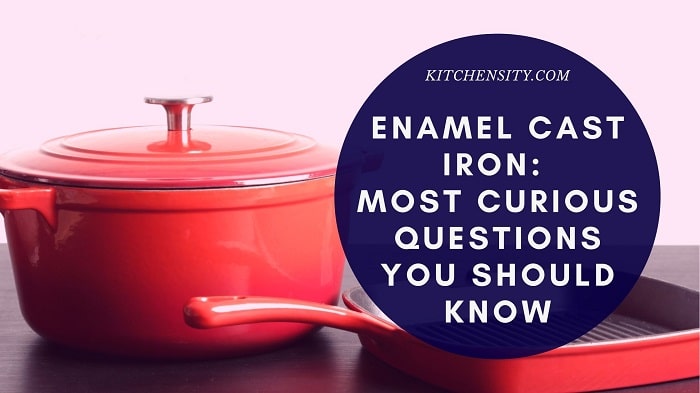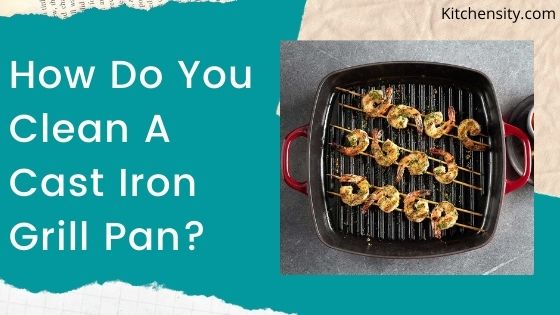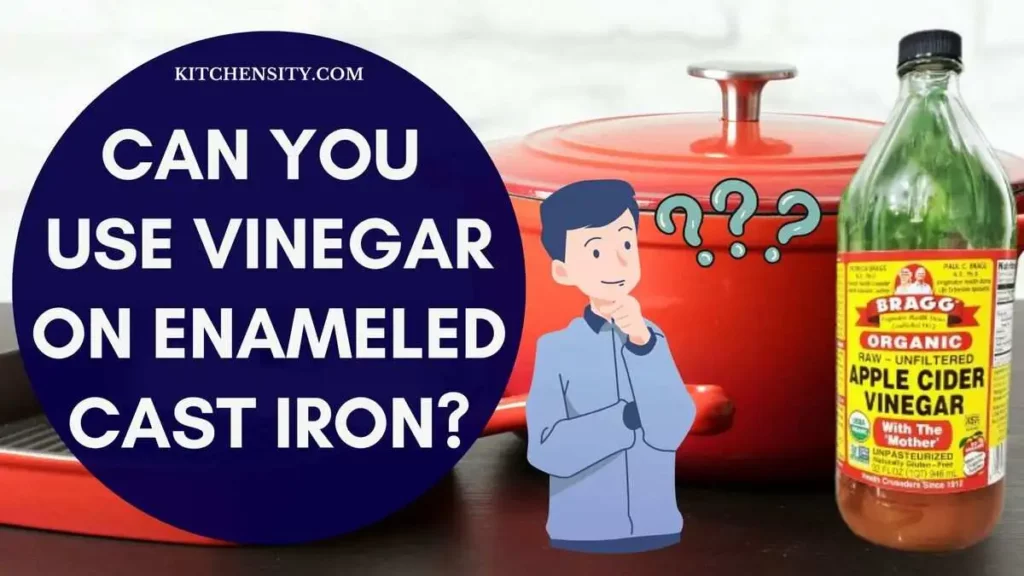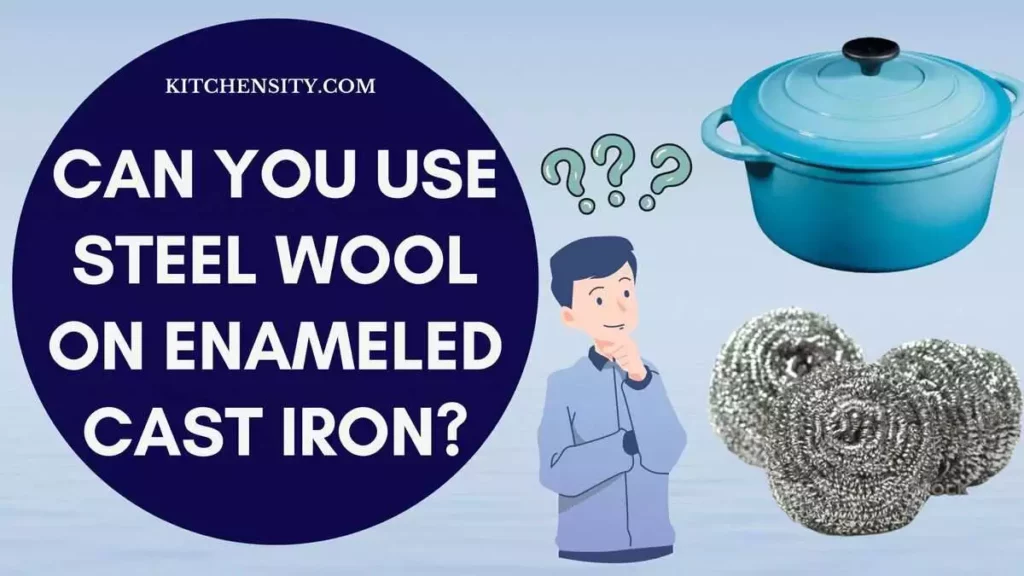Are you wondering if you need to season your enameled cast iron cookware?
Enameled cast iron pans are known for their smooth coating, providing a nonstick surface that is both practical and visually appealing.
However, the question of whether seasoning is necessary for enameled cast iron often arises.
In this article, we aim to demystify the topic, shed light on the advantages of seasoning, and help you make informed decisions about caring for your enameled cast iron pans.
While traditional cast iron needs seasoning for a natural nonstick layer, enameled cast iron pans have an immediate nonstick surface due to their smooth enamel coating.
However, seasoning can still offer advantages by creating an even smoother surface, improving food release, and enhancing overall cooking performance.
In this article, we’ll delve into the seasoning process, provide step-by-step methods, and address common concerns, including whether popular brands like Le Creuset or Lodge require seasoning.
By the end, you’ll gain clarity on whether to season your enameled cast iron cookware and learn how to unlock its full potential.
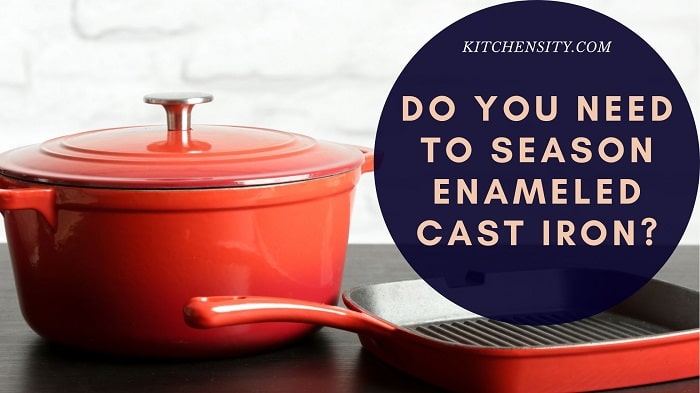
Table of Contents
- 1 Do You Need To Season Enameled Cast Iron?
- 2 Importance Of Seasoning For Enameled Cast Iron Cookware
- 3 How Do You Season An Enameled Cast Iron?
- 4 Frequency Of Seasoning For Enameled Cast Iron Cookware
- 5 Alternative Seasoning Options For Enameled Cast Iron Cookware
- 6 Common Concerns About Seasoning Enameled Cast Iron Cookware
- 6.1 1. Do You Need To Oil Enameled Cast Iron?
- 6.2 2. Do Specific Brands Like Le Creuset Or Lodge Require Seasoning?
- 6.3 3. When Should Enameled Cast Iron Dutch Ovens Be Seasoned?
- 6.4 4. What If I Accidentally Damage The Seasoning Layer?
- 6.5 5. Can I Use High Heat While Cooking In Enameled Cast Iron Cookware?
- 7 Maintenance And Cleaning
- 8 Final Verdict On Seasoning An Enameled Cast Iron Cookware
- 9 You May Also Like
- 10 FAQ’s
Do You Need To Season Enameled Cast Iron?
Seasoning enameled cast iron is optional, as the enamel coating already offers a nonstick surface. However, seasoning can further improve the smoothness and food-release properties of the cookware. The decision to season or not depends on individual preferences and desired cooking performance. Experimenting with seasoning can enhance your overall cooking experience.
Refer below for a step-by-step process.
Also Read – Can You Use Enameled Cast Iron On A Glass Cooktop?
Importance Of Seasoning For Enameled Cast Iron Cookware
Seasoning enameled cast iron cookware can bring several benefits to your cooking experience. Here are some reasons why seasoning is important:
- Enhanced Nonstick Properties:
- While enameled cast iron cookware already has a smooth coating that prevents food from sticking, seasoning can further improve its nonstick properties.
- Seasoning creates a thin layer of polymerized oil on the surface, which helps to fill any microscopic imperfections and provides an additional layer of protection against sticking.
- Improved Flavor Development:
- Seasoning can contribute to better flavor development in your dishes.
- As the seasoned surface gradually builds up a layer of oil, it can enhance the caramelization and browning of food.
- This can result in richer flavors and appealing crusts on meats, vegetables, and other ingredients.
- Easier Cleaning:
- A well-seasoned enameled cast iron surface is easier to clean.
- The seasoned layer helps to prevent food from adhering stubbornly to the pan, making it simpler to remove residue and perform regular maintenance.
- With proper seasoning, you can often clean your cookware by simply wiping it with a soft cloth or rinsing it with warm water.
- Prevention Of Rust And Corrosion:
- Although the enamel coating on cast iron cookware protects it from rust, seasoning can provide an additional barrier against moisture and corrosion.
- The seasoned layer acts as a protective shield, preventing the underlying cast iron from coming into contact with water or acidic ingredients that may damage it over time.
- Longevity And Durability: Regular seasoning helps to maintain the integrity and longevity of your enameled cast iron cookware. By creating a protective layer, seasoning can help prevent the enamel from chipping or wearing off, ensuring that your cookware remains in excellent condition for years to come.
- Personalized Cooking Surface: Seasoning enameled cast iron cookware allows you to customize the cooking surface according to your preferences. As you continue to season the pan, the seasoned layer builds up and develops its unique characteristics. Over time, this can lead to a smooth, naturally nonstick surface that is tailored to your cooking style.
Remember that while seasoning can offer these benefits, the process may need to be repeated periodically due to the non-porous nature of the enamel coating.
Regular maintenance and re-seasoning are essential to maintain the desired properties of your enameled cast iron cookware.
By seasoning your enameled cast iron cookware, you can enjoy improved nonstick properties, enhanced flavor development, easier cleaning, and prolonged durability.
It’s a worthwhile investment of time and effort that can greatly enhance your cooking experience.
Also Read – Can You Put Enamel Cast Iron In The Dishwasher?
How Do You Season An Enameled Cast Iron?
Seasoning an enamel cast iron skillet is almost similar to seasoning the other cookware. You will only require high smoke-point oil, a paper towel, and a heat source, that’s it.
But due to the enamel coating, the seasoning will not be a permanent one. You have to redo it from time to time because the enamel coating is made of glass, and the coating will be wiped off after some usage.
This will not happen in the case of regular cast iron skillets because there are many pores that help in the polymerization of the molecules and hence absorb the oil molecules much better.
Without any delay let’s learn to season an enameled cast iron skillet.
Items Required
- Wax or Grapeseed Oil
- Paper Towel or Soft Cloth
- Oven/Stove
- Heat Resistant Gloves Or Cloth
Seasoning Process for Enameled Cast Iron Cookware
- Step 1: Cleaning the Pan Before seasoning your enameled cast iron cookware, ensure that it is clean and free from any food residue.
- Use warm water, mild dish soap, and a soft sponge or cloth to gently clean the surface.
- Avoid using abrasive cleaners or scrubbers that may damage the enamel coating. Rinse the pan thoroughly and dry it completely.
- Step 2: Choosing the Oil For seasoning, it’s best to use a high smoke-point oil that can withstand the heat.
- Common options include vegetable oil, canola oil, grapeseed oil, or flaxseed oil.
- Avoid oils with low smoke points, such as olive oil, as they may burn and leave a sticky residue.
- Select a neutral-flavored oil to prevent it from imparting any unwanted flavors to your food.
- Step 3: Applying the Oil There are two methods you can use to apply the oil: wax or directly pouring the oil onto the pan.
- Wax Method: Take a small amount of food-grade wax (such as beeswax) and rub it onto a paper towel. Apply the wax evenly across the entire surface of the pan, including the corners and edges. Ensure that you cover the pan thoroughly but with a thin layer of wax.
- Oil Method: Pour approximately 2 tablespoons of your chosen oil onto the surface of the pan. Use a paper towel or soft cloth to spread the oil evenly across the entire cooking surface, ensuring that all areas are covered.
- Step 4: Heat Source Now, it’s time to heat the pan to allow the oil to polymerize and create the seasoned layer. You have two options for the heat source: the oven or the stovetop.
- Oven Method: Preheat your oven to around 320°F (160°C). Place the pan upside down on the middle rack. Let it heat in the oven for about 25 minutes, or until you notice the oil beginning to smoke. This process helps the oil penetrate the enamel and bond to the surface.
- Stovetop Method: Place the pan on a stovetop burner over high heat for approximately 10 minutes. Monitor the pan closely to ensure that the oil heats up and begins to smoke. This method allows for a more controlled and direct application of heat to the pan.
- Step 5: Cooling and Wiping Down Once you see the smoke indicating that the seasoning process is complete, carefully remove the pan from the heat source. Be cautious as the pan will be hot. Allow it to cool down completely before handling it.
Once the pan has cooled, take a clean paper towel or soft cloth and gently wipe down the surface. This step helps remove any excess oil and ensures that the seasoned layer remains thin and evenly distributed.
Also Read – Can You Use Vinegar On Enameled Cast Iron?
Frequency Of Seasoning For Enameled Cast Iron Cookware
It’s important to note that the enamel coating on cast iron cookware is not as porous as traditional cast iron.
As a result, the seasoned layer formed on the enamel surface may not be as long-lasting or as effective in creating a nonstick surface.
Therefore, periodic re-seasoning is necessary to maintain the desired nonstick properties and prevent food from sticking to the surface.
The exact frequency of re-seasoning will depend on several factors, including the frequency of use, the type of cooking techniques employed, and the care taken during cleaning and maintenance.
As a general guideline, it is recommended to re-season enameled cast iron cookware every few months or as needed.
Here are a few indicators that it’s time to re-season your enameled cast iron cookware:
- Food Begins To Stick: If you notice that food is sticking to the cooking surface more frequently, it is a sign that the seasoned layer has worn off or degraded. Re-seasoning will help restore the nonstick properties.
- Uneven Cooking: If you observe uneven heating or cooking performance, with some areas of the pan heating more quickly than others, it could be an indication that the seasoned layer has become inconsistent or worn out.
- Loss Of Sheen: Over time, the sheen or luster of the enamel coating may diminish, indicating the need for re-seasoning. This can happen due to regular use, cleaning agents, or high heat exposure.
When re-seasoning enameled cast iron cookware, follow the same steps outlined in the seasoning process, ensuring thorough cleaning and even application of oil. Be sure to remove any excess oil after seasoning to prevent buildup or a sticky residue.
- By re-seasoning your enameled cast iron cookware periodically, you can maintain its nonstick surface, enhance its performance, and prolong its lifespan.
- Additionally, proper care and maintenance, including gentle hand washing, avoiding harsh abrasives, and storing the cookware in a dry place, will contribute to the longevity of the seasoned layer.
Remember, the goal of re-seasoning is to fill in any pores or gaps in the enamel coating and create a smooth, protective layer that enhances the nonstick properties of the cookware.
Also Read – Can You Use Steel Wool On Enameled Cast Iron?
Alternative Seasoning Options For Enameled Cast Iron Cookware
While we suggest using wax or grapeseed oil for seasoning enameled cast iron cookware, other high smoke-point oils can be equally effective.
Here are a few additional options to consider:
- Flaxseed Oil: Flaxseed oil is a popular choice for seasoning cast iron due to its high smoke point and ability to form a durable seasoning layer. It creates a hard, slick surface that improves the nonstick properties of the cookware.
- Avocado Oil: Avocado oil is another excellent choice for seasoning enameled cast iron. It has a high smoke point and contains beneficial fats that contribute to a smooth and long-lasting seasoning layer.
- Coconut Oil: Coconut oil is a versatile option for seasoning cookware. It has a high smoke point and can create a protective layer that adds to the nonstick properties of enameled cast iron.
- Canola Oil: Canola oil is a commonly available oil with a high smoke point, making it suitable for seasoning cast iron. It forms a polymerized layer that enhances the nonstick performance and durability of the cookware.
When selecting an alternative oil for seasoning, ensure that it has a high smoke point (above 400°F/204°C) to withstand the seasoning process.
Apart from using different oils, there are specialized seasoning products available in the market that can simplify the seasoning process. These products often come in the form of pastes or sprays specifically designed for cast iron cookware.
They typically contain a combination of oils and other ingredients that aid in creating a smooth and long-lasting seasoning layer. These products can be a convenient option for those who prefer a hassle-free seasoning process or want to explore different flavor profiles.
It’s important to follow the manufacturer’s instructions when using alternative oils or seasoning products.
Each product may have specific recommendations for application methods, temperatures, and durations. Always ensure proper ventilation when seasoning cookware, as the process can generate smoke.
By considering these alternative oils and seasoning products, you can find the method that suits your preferences and achieve a well-seasoned enameled cast iron cookware with enhanced nonstick properties.
Also Read – Can You Put Enameled Cast Iron In The Oven?
Common Concerns About Seasoning Enameled Cast Iron Cookware
1. Do You Need To Oil Enameled Cast Iron?
Unlike traditional cast iron cookware, oiling enameled cast iron is not necessary for regular use. The enamel coating on enameled cast iron provides a smooth and nonstick surface, eliminating the need for oiling before cooking. The enamel acts as a protective barrier between the food and the cast iron material, preventing direct contact and reducing the risk of food sticking.
However, there are certain situations where applying a light coat of oil to the enameled surface can be beneficial.
- For example, if you’re storing your enameled cast iron cookware for an extended period or if you notice signs of the enamel coating deteriorating, applying a thin layer of oil can help prevent rust and maintain the cookware’s condition.
- When oiling enameled cast iron for storage or maintenance purposes, it’s essential to use a very minimal amount of oil.
- Simply apply a thin coat of high smoke points oil, such as vegetable oil or canola oil, to the cookware’s surface using a paper towel or soft cloth. Make sure to cover all exposed areas of the enamel.
- After oiling, store the cookware in a dry place with good ventilation to prevent moisture buildup. When ready to use the enameled cast iron again, wipe off any excess oil before cooking.
It’s worth noting that regular oiling is not required for enameled cast iron cookware during normal use.
The enamel coating provides sufficient protection and a nonstick surface, making it unnecessary to oil the cookware before each use.
Also Read – How To Clean A Cast Iron Grill Pan?
2. Do Specific Brands Like Le Creuset Or Lodge Require Seasoning?
Le Creuset and Lodge are popular brands known for their high-quality enameled cast iron cookware.
In recent years, many of these brands have started producing pre-seasoned enameled cast iron cookware, which means they come ready to use right out of the box.
These pans have been treated with oil and high heat during the manufacturing process to create a seasoning layer. Therefore, seasoning may not be necessary for these specific brands.
However, some enthusiasts still choose to season their pre-seasoned cookware to enhance its nonstick properties further and improve the overall cooking experience.
Also Read: How To Season And Clean Cast Iron Cookware?
3. When Should Enameled Cast Iron Dutch Ovens Be Seasoned?
Enameled cast iron Dutch ovens are versatile and commonly used for slow cooking, braising, and baking. The decision to season an enameled cast iron Dutch oven depends on personal preference and specific cooking requirements.
If you find that food is sticking to the surface while cooking in your Dutch oven, then seasoning can help create a smoother, more nonstick surface.
However, if you enjoy the flavor that comes from food sticking to the pan, you may choose not to season it.
In any case, it is generally recommended to season an enameled cast iron Dutch oven before its first use to establish a protective layer and ensure better cooking performance.
Also Read – Why Does Food Stick To My Enamel Cast Iron?
4. What If I Accidentally Damage The Seasoning Layer?
If the seasoning layer on your enameled cast iron cookware gets damaged, whether due to improper cleaning, using harsh abrasives, or overheating, you can re-season the pan to restore its nonstick properties.
Simply follow the seasoning process outlined earlier, ensuring that the damaged areas are properly coated with oil during the seasoning process. Re-seasoning will help rebuild the protective layer and improve the cooking surface.
5. Can I Use High Heat While Cooking In Enameled Cast Iron Cookware?
Enameled cast iron cookware is designed to withstand high heat, and it distributes heat evenly, making it suitable for various cooking methods.
However, it’s important to avoid sudden extreme temperature changes, as this can potentially cause thermal shock and damage the enamel coating.
Additionally, excessive heat can cause the seasoned layer to degrade over time. It’s recommended to use moderate to medium heat settings for most cooking tasks to ensure optimal performance and prolong the lifespan of the seasoning layer.
Also Read – Does Enamel Cast Iron Chip?
Maintenance And Cleaning
Proper maintenance and cleaning are essential to preserve the seasoned surface and prolong the lifespan of your enameled cast iron cookware.
Here are some tips to help you care for your seasoned cookware:
- Avoid Harsh Cleaning Agents: To protect the seasoned surface, it’s important to avoid using harsh cleaning agents such as abrasive cleaners, metal scouring pads, or harsh chemical detergents. These can damage the enamel coating and strip away the seasoning layer.
- Hand-Wash With Mild Soap: After each use, hand-wash your enameled cast iron cookware with warm water and mild dish soap. Gently scrub the surface with a soft sponge or cloth to remove any food residues. Avoid soaking the cookware for extended periods, as this can affect the seasoning.
- Avoid Extreme Temperature Changes: Rapid temperature changes can cause thermal shock and potentially damage the enamel coating. Avoid transferring hot cookware directly to a cold surface or exposing it to cold water immediately after use. Allow the cookware to cool down gradually before washing.
- Stubborn Stains And Residues: If you encounter stubborn stains or residues, create a paste using baking soda and water. Apply the paste to the stained areas and let it sit for a while. Then, gently scrub with a soft sponge or cloth. Rinse thoroughly and dry the cookware.
- Dry Thoroughly: After washing, ensure that your enameled cast iron cookware is thoroughly dried. Moisture can promote rusting, so use a soft cloth or paper towel to remove excess water. Allow the cookware to air dry completely before storing it.
- Storing Properly: To prevent scratching or chipping, stack your enameled cast iron cookware with protective padding or use individual cloth pan protectors. Avoid stacking heavy items on top of the cookware, as this can cause damage.
- Seasoning Touch-Ups: Over time, the seasoning layer may wear off due to regular use and cleaning. To maintain the nonstick properties, you may need to periodically re-season your enameled cast iron cookware. Follow the seasoning process outlined in the earlier section to refresh the seasoning layer.
Final Verdict On Seasoning An Enameled Cast Iron Cookware
In conclusion, the decision to season your enameled cast iron cookware ultimately depends on your personal preferences and cooking needs.
While enameled cast iron pans come with a nonstick surface right out of the box, seasoning can further enhance their performance by creating a smoother cooking surface and improving food release.
By following the step-by-step seasoning methods and considering the specific needs of your cookware, you can maximize its potential and enjoy effortless cooking experiences.
Remember, periodic re-seasoning may be necessary for enameled cast iron due to the non-porous nature of the enamel coating.
This ensures that your pan maintains its nonstick properties over time. Whether you choose to season your enameled cast iron or not, proper maintenance and cleaning are essential for its longevity.
By avoiding harsh cleaning agents and abrasive scrubbers, you can preserve the enamel coating and enjoy your enameled cast iron cookware for years to come.
You May Also Like
- Is Enameled Cast Iron Cookware Safe?
- Cast Iron Skillet Gift Basket Ideas
- Best Enameled Cast Iron Cookware Sets
- Best Cast Iron Pots And Pans Set
- How Many Quarts In An 8×8 Pan?
- How Many Quarts Are In A 9×9 Pan?
- How Many Quarts In A 9×13 Pan?
- Skillet Vs Frying Pan Vs Sauté Pan
FAQ’s
-
Do I Need To Season My Le Creuset Skillet?
Le Creuset cast iron or any other major brand cookware comes pre-seasoned nowadays. The company claimed it as a ready-to-use product. But if you season the pan, it will become more smooth and you will love cooking in it.
-
Should I Season Lodge Enameled Cast Iron?
The lodge enameled cast iron cookware is excellent and is very smooth due to its glass coating. You don’t need to season it right after purchase. You can use it for some time and then you can season it for continuing the smoothness and ease of cooking.
-
Do I Need To Season My Enameled Dutch Oven?
Enameled Cast Iron Dutch Ovens serve various purposes, and if food sticks while cooking, seasoning is recommended; otherwise, it may not be necessary. For those who enjoy the flavor that comes from stuck food, seasoning may not be needed.
However, to ensure a smooth and comfortable cooking experience, it is generally advisable to season the Dutch oven beforehand.
Katrina Smith is a seasoned expert with over 25 years of experience in all things related to cooking and the kitchen. As an avid cook and kitchen enthusiast, she is passionate about sharing her knowledge and expertise on cookware, kitchen appliances, kitchen tips, and kitchen staples.
Through her articles and reviews, Katrina aims to inspire and help others improve their cooking skills, experiment with different ingredients, and invest in quality cookware and appliances.

![How To Season And Clean Cast Iron Cookware? [4 Effective Ways] 3 How To Season And Clean Cast Iron Cookware](https://www.kitchensity.com/wp-content/uploads/2020/06/How-To-Season-And-Clean-Cast-Iron-Cookware.jpg)
